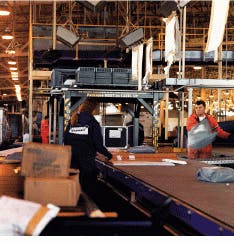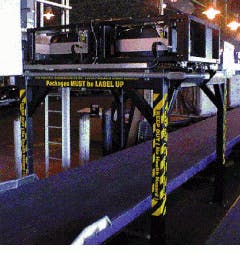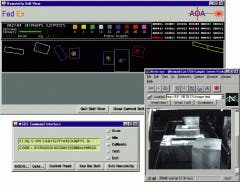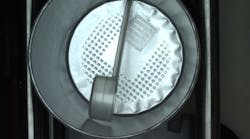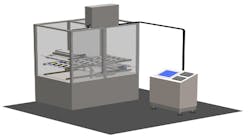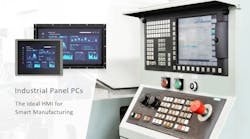Machine vision and barcode inspection identify fast-moving parcels
By Lawrence J. Curran, Contributing Editor
Sorting, measuring, identifying, and delivering millions of parcels per day demands a cost-effective, accurate, and automatic inspection system. To meet those goals, the Mass Scanning and Dimensioning System (MSDS) from Adaptive Optics Associates Inc. (AOA; Cambridge, MA), a unit of United Technologies` Hamilton-Standard Division, integrates machine-vision and barcode-scanning technologies that improve all aspects of parcel handling at numerous facilities of Federal Express Corp. (FedEx; Memphis, TN).
Recently, FedEx and AOA joined forces to overcome the difficulties related to parcel inspection. FedEx designed the MSDS system, and AOA produced it. Nearly 70 such systems have been installed in 22 FedEx hub facilities, substantially improving the overnight carrier`s ability to deliver packages.
Because FedEx ships about a million packages a day, time is a highly critical cost factor in the scanning inspection of different-sized parcels as they travel at fast speeds on a conveyor belt. Moreover, this scanning process must identify odd-shaped parcels mixed in with regularly shaped ones. All these different-shaped parcels must be accurately identified without disrupting the package flow.
The MSDS can sense dimensions to within 0.5 in. in length and width and within 0.25 in. in height. It can handle parcels that measure up to 8 ¥ 5 ¥ 3 ft that are moving at rates ranging from 80 to 300 ft/min (see Fig. 1). What`s more, it can measure large- and small-sized parcels that are closely bunched together and can also relate their volumes to their weights. The volume-to-weight relationship aids in the efficient loading of aircraft and in determining billing. The MSDS determines that relationship using scanners that match a parcel`s dimensions in real time and at high speed to its barcode-identification number.
FedEx began a search in 1994 to find an inspection technology, along with a reliable supplier of such a system, that could capture weight and volume data in a manner that would not disrupt the company`s existing and relatively smooth parcel-handling operations. Brett Bonner, manager of system engineering in the FedEx scan-systems-development department, undertook that investigation with the goal of performing simultaneous barcode scanning and parcel-dimension measurements.
Bonner says his department initially intended to develop the MSDS in-house, but asked for bids to determine whether FedEx could outsource the development work. Ultimately, AOA`s response to the bid package proved so attractive that FedEx selected and worked closely with AOA to produce the MSDS system, Bonner says.
Development and test phases
Anderson Maddocks, AOA director of marketing, explains that FedEx initially asked AOA and a competitor to develop combined scanning and measuring systems that would work on `nonsingulated` parcel streams, that is, a stream that has parcels or packages irregularly strewn on a conveyor belt, often touching each other. These packages might be moving at 80 to 200 ft/min. (A `singulated` stream consists of a single layer of packages moving in the same direction with space between them, although they may be densely arranged across a conveyor belt that moves as fast as 300 ft/min.)
"That`s a daunting flow of parcels," Maddocks says of the nonsingulated stream. "The people picking and placing parcels onto a belt may see five or six go by that are unusually large or odd-shaped, but they don`t have time to weigh and measure them. This is the task we had to meet in the prototype system," he says.
AOA developed a prototype in six months that was able to identify and measure individual parcels even when many are closely bunched, identify shapes so that a barcode scanner could be pointed and focused to read the barcode, and match the correct measurements of a parcel to its barcode- identification number.
The barcode scanner had to identify a particular parcel, as well as the parcel`s origin, destination, weight, and account billing information. The system FedEx sought also had to add the parcel`s dimensions to that information and then send all the data to a FedEx management information system. FedEx also wanted data that could assist in performing labor trend analyses by gathering statistics on parcel flow related to time of day or night to suitably staff the pick-and-place operation. It could therefore tabulate parcel weight-to-volume ratios to help in determining aircraft freight loading, enabling more economical aircraft use and fuel consumption.
As part of its initial effort, AOA developed its own barcode scanner for the prototype system. Maddocks says the company "did very well" at dimensional measurements in a six-month test. The competitor, a manufacturer of barcode scanners, successfully handled the barcode part of the inspection, but didn`t fare as well in dimensional measurements, according to Maddocks.
"We were asked to move to the next development phase, but FedEx asked us to use the competitor`s barcode scanner," Maddocks relates. "That wasn`t a problem because we were looking for the best system-level machine-vision solution possible. We`ve always aimed at computer-based measurement systems and instruments, not components," he explains.
Since winning the contract, AOA has delivered more than 70 MSDSs to FedEx, which has installed 68 systems and plans to introduce a MSDS to all of its hub and ramp facilities during the next three years.
System capabilities
The first version of the MSDS system was built around a computer architecture that included four Unix-based VME boards, a Sparc-based CPU board from Themis Computer Corp. (Fremont, CA), an array-processor board from Sky Computers Inc. (Chelmsford, MA) that incorporates four i860 processors from Intel Corp. (Santa Clara, CA), and two TMS320-based DSP boards from Ariel Corp. (Cranbury, NJ). AOA will begin shipments of the second version of the MSDS system, which incorporates dual Pentium- and Windows NT-based computers, in the first quarter of next year. Both versions will be compatible with FedEx`s information-management systems. For both systems, the dimension-scanning array is built on a vibration-isolated stand, which is attached to a floor-mounted steel frame. The rugged frame is designed to maintain a fixed relationship between the scanners and their associated conveyor belts, says Maddocks (see Fig. 2).
The system-supporting electronics rack is housed in a separate enclosure that can be located as far as 50 feet away from the conveyor belt. The principal components stored in the rack include the computer chassis, barcode scanner chassis, ac power controller, uninterruptible power supply, and heating and air-conditioning units, which are used to maintain an adequate working temperature for the inspection system no matter what climatic conditions the facility encounters.
"We wanted an open architecture with as many standard parts as possible," Maddocks says. For example, AOA`s profiling dimensioning scanner comes from Mettler-Toledo Inc. (Worthington, OH), selected especially to obtain highly accurate parcel-height measurements. The barcode scanners are Accusort Omni-X units (Telford, PA), which are modified optically to enhance their ability to change focal lengths for this application.
The MSDS software matches the parcel-dimension data to the barcode scan data. The rack computer processes the sensed outputs to make them compatible with FedEx computers and information systems.
Laser radar
"We use some unusual technology for machine vision," Maddocks reports. "For example, the profiling-dimensioning scanner uses laser radar to obtain package dimensions." The profiler generates package-height data as a function of package position across the belt, and the computer begins to develop a profile of the package stream. The laser radar emits parallel eye-safe beams from above the conveyor belt that are aimed straight down at the packages streaming below.
The laser beams are reflected directly back up to the scanner, and the system measures the round-trip travel time of each beam from emission to return. "Short travel time means a high parcel; long travel time is associated with a short parcel," Maddocks explains. In this manner, the MSDS builds a precise vertical contour of the package stream.
"Because these are nonsingulated parcel streams, it`s absolutely critical that the laser beams are perfectly vertical," says Maddocks. For example, more-conventional scanners sensing a passing 2-in.-high package that closely abuts a 40-in.-high package might not detect the top of the shorter package because their `view` is at an oblique angle. "Our [vertical scanning] ability separates us from machine-vision companies that are good at digital signal processing after data acquisition but don`t understand the physics of the scanning problem," Maddocks contends (see Fig. 3).
The MSDS incorporates three barcode scanners, each of which has three scanning laser beams performing crisscross scans that can be independently focused. This design eliminates the problem of one package obscuring any barcode "because the resulting nine beams make enough crisscross scans to create a tunnel" with sufficient redundancy so that the barcode will always be seen, says Maddocks.
Integration and interpretation
Collecting all the information in real time is a challenge, but interpreting it correctly to deliver reliable data to the computer about parcels in a nonsingulated stream is a key contribution made by the MSDS software, according to Maddocks. "Information processing has to be done in real time while packages are moving at high speed because the conveyor belt can`t be slowed down during peak shipping periods."
He also says that, depending on belt width, two or three laser-radar dimensioning profilers may be used, and "their outputs have to be [electronically] stitched together." Because the return scans from each of these profilers is slightly curved, the software must correct that curvature. In addition, because these profiling scanners operate separately from the barcode scanners, their dimension data must be correlated with the barcode data. The complexity of this task required AOA to develop multiprocessing real-time fault-tolerant software that provides multiple redundancy.
In 1994, no single computer was available that could perform all the image-processing and control tasks required for this parcel-inspection application, according to Maddocks. AOA had to develop the MSDS software so that it directed distributed processing among multiple processors, "keeping the data in lockstep so that things happened in parallel." This processing requires a processor to synchronize simultaneous profiling dimensional scans with barcode scans "to keep the correct box linked to the correct measurements," Maddocks says. "We needed a lot of communication mechanisms in the software to keep the various parts working together," he adds.
Partnership emerges
O. P. Skaaksrud, FedEx senior engineer in scan-systems development, describes MSDS as a joint effort. "The fundamental design was ours and [AOA] expanded on it," he says. "We worked with them to change some key components." For example, FedEx`s experience using barcode scanners suggested that the initial AOA barcode scanner was too large and not fast enough to keep pace with conveyor belts running at rates to 200 ft/min on a nonsingulated line. For this reason, the alternate barcode scanner was chosen.
AOA`s Bonner says FedEx derives other operational benefits from using the MSDS, which is especially adept at handling "nonconveyables, the odd-sized parcels that present a complicated task just to count them," he points out. Those parcels previously had to be manually counted and keyed into a computer to calculate parcel flow rates. It was a batch job that couldn`t be done in real time.
"Now, we have instant information because we can count the number of parcels we have before they`re sorted, and we can calculate how long it will take to sort and load them," Bonner says. He points out that some facilities using the batch system didn`t know how much volume they handled. "Now we know the volume before unloading and first sorting the quantities we`re dealing with," he adds.
Throughput and availability
With the MSDS version currently operational, FedEx is measuring the dimensions of more than 1 million packages per day in various facilities. This figure is expected to jump to 1.6 million a day "when the system is fully rolled out," according to Bonner. More important, MSDS has taken 3 min off the sort time required in some major facilities, "and that`s a very big saving," Bonner emphasizes. FedEx`s Skaaksrud adds that MSDS has enabled the company to `dramatically in crease` the loading density of its conveyor belts. The system also delivers "very high reliability, which is measured at 99% availability," Bonner maintains.
The MSDS is still evolving, according to Skaaksrud. For example, the system has been expanded to in clude more operational features, such as guidelines to provide both the optimum loading profiles of freight containers and the optimum labor force needed to process the parcel flow.
And although the MSDS was designed for the difficult processing of odd-shaped parcels, the company has discovered a bonus: the system also works well with conveyables, small parcels that form a large percentage of the company`s volume. The MSDS is able to keep pace with the 300-ft/min speeds typical of these types of parcels.
Bonner says one of the most recent MSDS installations in Memphis adds a new twist. Nine MSDS scanners are linked to 256 Gbytes of disk storage, enabling FedEx to store and recall the outline of any parcel, the belt conditions as that parcel is sorted, and the destination-related barcode vectoring data. These capabilities are valuable customer-service tools, he says.
FIGURE 1. The Mass Scanning and Dimensioning System (MSDS) can scan and identify boxes and packages to within 0.5 in. in length and width and within 0.25 in. in height. The system determines these parameters using scanners and a variety of array, CPU, and DSP boards that match a parcel`s dimensions in real time and at high speed to its barcode-identification number.
FIGURE 2. In the Mass Scanning and Dimensioning System, the laser-based dimension-scanning array is positioned on a vibration-isolated stand, which is attached to a floor-mounted steel frame. The frame maintains a fixed relationship between the scanners and the conveyor belts.
FIGURE 3. In addition to parcel-handling and billing information, the Mass Scanning and Dimensioning System yields height dimension data to accommodate parcel rates, volumes, and loading statistics. The parcel heights are displayed on a system monitor along with parcel location and identification data. The system can also detect stacked parcels and display warnings at a local or central monitoring station.
